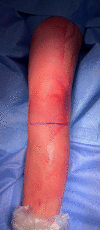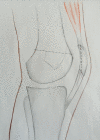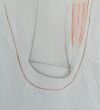Modified Gritti-Stokes amputation: tips and tricks
- PMID: 38579767
- PMCID: PMC11044088
- DOI: 10.1530/EOR-23-0118
Modified Gritti-Stokes amputation: tips and tricks
Abstract
Major amputations of the lower extremity may be required after trauma and a variety of underlying diseases such as peripheral vascular disease, diabetes, and malignancies. The goal of any major amputation is an optimal functional result with a maximum limb length in combination with optimal wound healing. The preservation of the knee joint is essential for successful rehabilitation, and this is best achieved by the Burgess below-knee amputation (BKA). Whenever a BKA is not possible, the Gritti-Stokes amputation is our first choice. This technique mainly consists of a through-knee amputation with the creation of a pedicled patella flap consisting of the patella, patellar ligament, and overlying soft tissue. After osteotomy of the distal femur and resection of the articular surface of the patella, the anterior flap is rotated in order to cover the femur defect while performing a patellofemoral arthrodesis. The aim of this paper is to describe our surgical technique and experience with GSA and to point out the important steps of this procedure. In conclusion, GSA is an excellent surgical option for patients requiring major lower limb amputations where BKA cannot be considered. Particular attention must be paid to careful preoperative evaluation and optimization of comorbidities. A meticulous surgical technique is warranted, including atraumatic tissue handling and an optimal patellofemoral arthrodesis technique.
Keywords: Gritti–Stokes; amputation; lower limb; trans-knee amputation.
Conflict of interest statement
The authors declare that there is no conflict of interest that could be perceived as prejudicing the impartiality of the study reported.
Figures












Similar articles
-
A Reevaluation of the Gritti-Stokes (Above-Knee) Amputation for the Nonambulatory Patient.Ann Vasc Surg. 2019 Oct;60:468-473. doi: 10.1016/j.avsg.2019.03.006. Epub 2019 Jun 12. Ann Vasc Surg. 2019. PMID: 31200050
-
Role of Gritti-Stokes amputation in peripheral vascular disease.Ann R Coll Surg Engl. 1997 Mar;79(2):102-4. Ann R Coll Surg Engl. 1997. PMID: 9135235 Free PMC article.
-
Gritti-Stokes Amputation in the Trauma Patient: Tips and Techniques.JBJS Essent Surg Tech. 2012 Apr 11;2(2):e7. doi: 10.2106/JBJS.ST.K.00048. eCollection 2012 Apr. JBJS Essent Surg Tech. 2012. PMID: 31321130 Free PMC article.
-
The Gritti-Stokes Amputation: Is It Still a Reliable Technique in the 21st Century? A Narrative Review.Medicina (Kaunas). 2024 May 30;60(6):911. doi: 10.3390/medicina60060911. Medicina (Kaunas). 2024. PMID: 38929528 Free PMC article. Review.
-
A review of through-knee amputation.Vascular. 2022 Dec;30(6):1149-1159. doi: 10.1177/17085381211045183. Epub 2021 Nov 29. Vascular. 2022. PMID: 34844469 Free PMC article. Review.
Cited by
-
Modified Gritti-Stokes amputation for periprosthetic fracture with irremovable femoral nail: case report and review of an overlooked procedure.Acta Orthop Traumatol Turc. 2025 Jun 5;59(4):232-236. doi: 10.5152/j.aott.2025.24213. Acta Orthop Traumatol Turc. 2025. PMID: 40728084 Free PMC article. Review.
References
-
- Faber DC & Fielding LP. Gritti-Stokes (through-knee) amputation: should it be reintroduced? (through-knee). Southern Medical Journal 200194997–1001. - PubMed
Publication types
LinkOut - more resources
Full Text Sources

